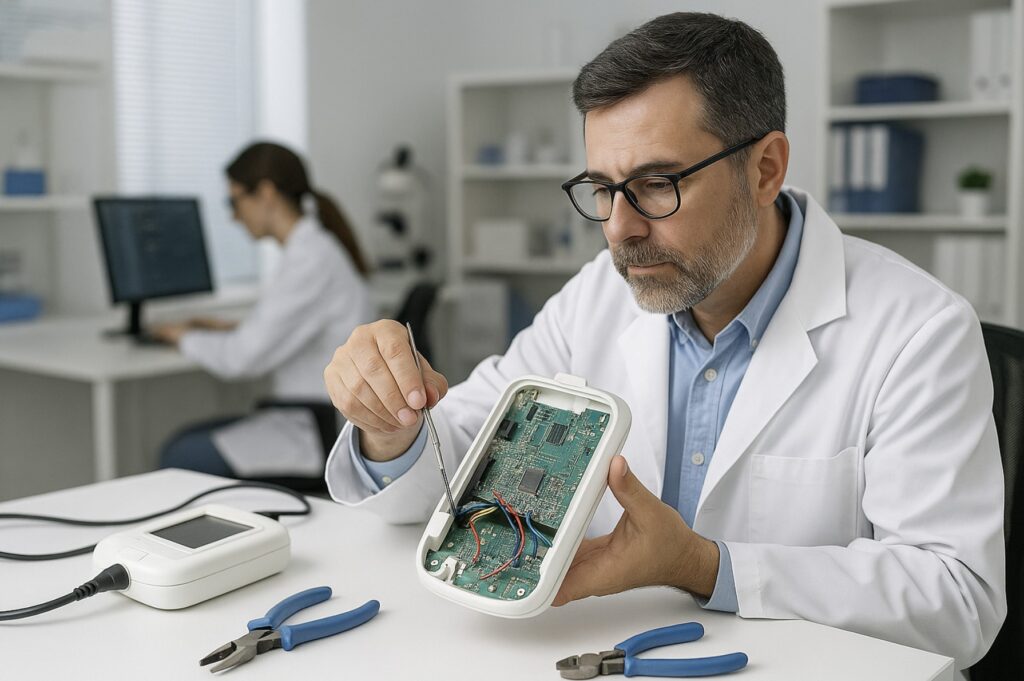Developing ISO 13485-certified medical devices demands a careful balance between engineering innovation, regulatory compliance, and precise manufacturing. From the earliest stages of pcb design to final validation and certification, every step must meet strict quality and documentation requirements. Companies that successfully integrate these standards not only achieve regulatory approval but also build a foundation for long-term reliability, patient safety, and market success.
ISO 13485 Product Development
ISO 13485 is the international standard that defines quality management system (QMS) requirements for organizations involved in the design, production, and servicing of medical devices. It focuses on risk management, traceability, and regulatory alignment, making it the cornerstone of medtech development. Product development under ISO 13485 requires a defined and documented process that covers design inputs, outputs, verification, validation, and post-market feedback.
In practice, ISO 13485 product development starts with user needs and regulatory requirements. These needs are translated into design specifications, which guide engineers and designers throughout the device lifecycle. Every change, test, and decision must be traceable. This traceability ensures that no aspect of performance or safety is left unchecked. For companies developing implantable devices, diagnostic systems, or wearable medtech, this standard is both a roadmap and a requirement for global market access.
The integration of a QMS under ISO 13485 is not just for compliance—it brings structure, repeatability, and measurable control. It helps minimize design errors, reduce recalls, and maintain consistency across all product lines.
Medical Device Design Firm
Partnering with a qualified medical device design firm can significantly simplify the ISO 13485 certification path. Such firms have multidisciplinary teams with experience in biomedical engineering, mechanical design, firmware development, and pcb design for medical electronics. They also understand how to translate design requirements into regulatory-compliant documentation.
A medical device design firm typically follows a stage-gate process that aligns with ISO 13485. Each gate represents a milestone where verification and validation are reviewed before proceeding. This structured approach minimizes risks and accelerates regulatory submissions to bodies like the FDA or Health Canada.
Choosing a partner with in-house prototyping, electrical engineering, and software integration capabilities can reduce development cycles. It also ensures better communication between disciplines, leading to fewer design iterations and more robust outcomes. Firms that already operate under ISO 13485 certification can seamlessly integrate your device into their existing quality system, simplifying audits and compliance reviews.
Medtech Design Certification
Certification under ISO 13485 signifies that the organization has a quality system capable of consistently producing safe and effective devices. It is not a one-time event but an ongoing process of maintaining compliance through continuous improvement, internal audits, and third-party inspections.
Medtech design certification includes demonstrating control over supplier management, design verification, production processes, and documentation. Every piece of evidence—from risk assessments to verification protocols—must be properly recorded. The certification process typically involves a gap analysis, documentation review, on-site audits, and corrective action implementation.
Companies seeking medtech design certification benefit from adopting digital document control systems. These systems manage change history, approvals, and traceability automatically. Cloud-based QMS platforms now allow design teams and auditors to collaborate remotely, reducing the administrative burden of compliance.
ISO 13485 certification is recognized globally, so achieving it opens international markets and simplifies approvals under systems like the EU MDR, MDSAP, and other regional frameworks.
Regulatory Design Standards
Medical devices are among the most highly regulated products in the world. ISO 13485 harmonizes with other regulatory standards such as FDA 21 CFR Part 820 (Quality System Regulation), ISO 14971 (Risk Management), and IEC 60601 (Electrical Safety for Medical Equipment). Together, these form a comprehensive compliance ecosystem.
During product development, the design team must identify applicable standards early in the project. Regulatory design standards influence everything from material selection and labeling to usability and sterilization validation. For instance, devices with electrical functions must comply with IEC 60601, while software-driven products may also need to meet IEC 62304.
Integrating these standards into the design process prevents costly redesigns later in development. It also supports smoother technical file submissions and faster approval timelines. Engineers and quality specialists work together to verify that design outputs meet both user requirements and regulatory criteria before release for production.
ISO 13485 Consulting
ISO 13485 consulting services are valuable for startups and established manufacturers seeking to upgrade their QMS or achieve first-time certification. Consultants guide organizations through the process of aligning their quality systems with ISO 13485 requirements, conducting gap analyses, drafting documentation, and preparing for audits.
An ISO 13485 consultant can also help in supplier qualification, design control implementation, and risk management integration. They provide templates and audit-ready documentation, saving companies months of internal development work. Experienced consultants often have backgrounds in regulatory affairs or engineering, providing practical insights into both technical and compliance challenges.
Some firms offer fractional quality management support, allowing smaller medtech companies to maintain compliance without hiring full-time staff. This scalable approach enables startups to achieve ISO 13485 certification efficiently and cost-effectively.
Medical Device Prototyping
Prototyping plays a critical role in medical device development. It bridges the gap between concept and production, allowing teams to validate design assumptions, test ergonomics, and confirm functionality. In an ISO 13485 environment, even prototypes are controlled through documented processes to maintain traceability.
Medical device prototyping often includes rapid 3D printing for mechanical parts, CNC machining for housings, and pcb design and assembly for electronic components. Each prototype must undergo risk assessment and verification testing, especially when human factors or safety features are involved.
For electronic medical devices, the prototype stage allows engineers to measure signal integrity, thermal behavior, and compliance with EMC standards. Early identification of electrical or mechanical issues saves significant time and cost before moving to formal validation testing.
Modern medtech development also incorporates Design for Manufacturability (DFM) and Design for Testability (DFT) principles during prototyping. This ensures that final designs can be scaled to production while maintaining quality consistency.
Compliant Design Processes
Compliant design processes form the foundation of ISO 13485 certification. These processes define how design inputs are transformed into validated outputs. A compliant process includes clear documentation of each stage: planning, design input, design output, verification, validation, review, and transfer to production.
Design controls require that all user and regulatory requirements are identified before any design work begins. Verification confirms that the design outputs meet those inputs, while validation ensures the final product fulfills its intended use in the real world. Any design changes after approval must go through formal review and documentation updates.
Key elements of compliant design processes include:
- Design plans that define activities, responsibilities, and milestones
- Risk management integrated throughout the design phase
- Configuration management to track revisions and maintain document integrity
- Verification and validation reports to demonstrate conformity
- Design history files (DHF) that serve as the record of the entire design process
Maintaining these records is essential for passing ISO 13485 audits and for future traceability in case of field issues or recalls.
Medtech Product Development
The medtech product development cycle involves a cross-functional team of engineers, designers, clinicians, and regulatory experts working toward a common goal—creating safe and effective devices for patient care. The process typically spans several stages: concept, design, prototyping, testing, validation, and production.
Concept development starts with identifying a clinical need and translating it into design requirements. Early engagement with physicians and end-users helps define usability and functionality. During design, engineers focus on material selection, pcb design for electronics, and integration of sensors or actuators. Prototypes are tested against regulatory standards and risk analyses are performed to mitigate potential hazards.
Once verification and validation are complete, the product undergoes pilot manufacturing and process validation. Final documentation is prepared for regulatory submission. Throughout this process, ISO 13485 dictates strict record-keeping, supplier control, and traceability, all of which are vital for maintaining compliance.
The ultimate goal is not only to meet the certification but to build a repeatable, auditable, and scalable development system that supports future device iterations.
Quality Management for Medical Devices
A robust quality management system (QMS) is central to ISO 13485. It establishes the policies, procedures, and records necessary to maintain control over every aspect of medical device production—from design and purchasing to assembly and distribution. Quality management ensures that processes are consistent, measurable, and continually improved.
ISO 13485 focuses heavily on risk-based thinking. Manufacturers must identify potential failures, evaluate their impact on patient safety, and implement controls to reduce risks. This approach applies not only to product design but also to supplier qualification, production, and post-market surveillance.
An effective QMS should include:
- Document control and training systems
- Internal audits and management reviews
- CAPA (Corrective and Preventive Action) tracking
- Process validation and calibration programs
- Customer feedback and complaint handling
By integrating these elements, organizations maintain readiness for regulatory audits while building a culture of accountability and quality excellence.

ISO 13485 Design Requirements
ISO 13485 design requirements are structured around risk management and documentation control. These requirements govern every phase of design and development, emphasizing verification, validation, and traceability. The goal is to ensure that every device consistently meets user needs and regulatory expectations.
Key design requirements include:
- Defining and documenting design inputs (performance, safety, regulatory criteria)
- Producing design outputs that can be verified and validated
- Conducting design reviews at planned intervals
- Managing design changes under formal control
- Maintaining a Design History File (DHF) as proof of compliance
Risk management under ISO 14971 is deeply integrated with these design controls. Each potential hazard is identified, evaluated, and mitigated through design or process controls. The risk analysis must be kept current throughout the product’s lifecycle, including post-market monitoring.
For organizations, meeting ISO 13485 design requirements means establishing a repeatable, well-documented process. This process not only satisfies auditors but also contributes to better product quality and patient outcomes.
Conclusion
Developing ISO 13485-certified medical devices is far more than a regulatory requirement—it’s a disciplined approach to quality, safety, and reliability. From pcb design to product validation, every detail must be controlled, verified, and traceable. Companies that master ISO 13485 principles gain a competitive edge in the medtech industry, achieving faster approvals, reduced recalls, and stronger customer confidence.
Integrating a compliant QMS, leveraging experienced design partners, and maintaining continuous improvement are the keys to long-term success. As technology advances and regulations evolve, the ability to adapt while maintaining ISO 13485 standards will define the next generation of medical device innovators.
